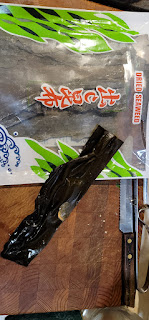Note: to be economical in your kitchen, one thing you might want to do, is to be clear with yourself what cuisines you like best. It is very easy to carry altogether too much in inventory, when your cooking styles are all over the piace. I like potatoes, and pasta and rice. They are all good complex carbs, if you use whole wheat flour and brown rice. Rice keeps fairly well, Pasta also, but not potatoes. I was raised with potatoes, but by the time I started living on my own, I became a little Chinaman, living on mostly rice, tofu, and veggies. But, I always had a reputation for cooking good pasta sauce, and while the precise recipes changed over the years, that remains a favorite. Then, later in life my tsste for potatoes came back.
All of that, just to say that Miso soup and miso soba are easy dishes if they fit your pantry. On the positive side, most of the ingredients keep rather well. Dried seaweed is an example, dried mushrooms is another. For the following recipe the fresh ingredients are some collard green leaves, some daikon, and some scallions. All the rest can be kept dry.
In the following recipe, I will assume that we begin making the soup at breakfast.
You rinse about a 1" to 2" wide strip of kombu, and put that on with 2 cups of fitered water. You add in the dried mushrooms, a teaspoon of hijiki and a teaspoon of wakame. Rinse them, before adding to the soup.
Cut up a 1/4 block of tofu in small cubes, and bring the whole thing to a boil, and let it simmer for a bit and then let it cool off.
Dry Ingredients:
1 1"-2"strip of kombu, rinsed
1 tsp hijiki, rinsed
1 tsp wakame, rinsed
1/4 block of tofu, cubed
1 handful of dried shiitake mushrooms
1 bundle soba noodles or whole grain ramen.
Bring to a low simmer and let it simmer for 10-15 minutes, and then let it cool off. Do this at breakfast if you want to have the noodles for lunch of dinner.
Preparation:
Presently, you reheat the now cooled off broth, and when it comes to a boil, you turn it completely low, and remove the kombu. Now come some more ingredients:
Fresh Ingredients:
3-5 Collard Green leaves, stem removed, rolled up, and cut in thin slices
1"-2" section of Daikon, julienned, katsumatsuki style cut
3 scallions sliced thin.
Assembly:
If using Soba, cook it separately in ample boiling water.
If using ramen, you can add them in the soup at the end, for about 4-5 minutes, as long as you make sure they are submersed long enough.
Cook the daikon and collards in the soup.
Meanwhile boil a cup of water to dissolve about 3 tbsp of miso, but let it cool briefly for you do not want to boil the miso.
Dissolve the miso. Mix it all in a bowl, and finish with the scallions.
Nutrition:
Clearly the noodles are the carbs
The leafy greens are there in abundance,
the tofu bumps up the protein a little bit
One ounce holds (please get the low sodium variety) :
- Calories: 56
- Carbs: 7 grams
- Fat: 2 grams
- Protein: 3 grams
- Sodium: 43% of the RDI
- Manganese: 12% of the RDI
- Vitamin K: 10% of the RDI
- Copper: 6% of the RDI
- Zinc: 5% of the RDI


























